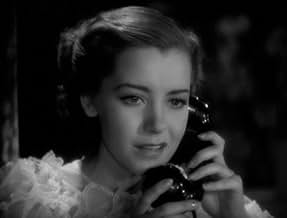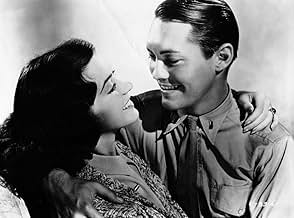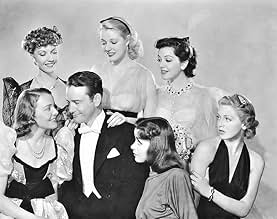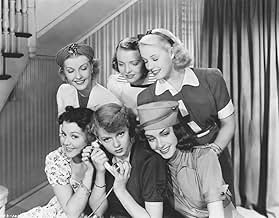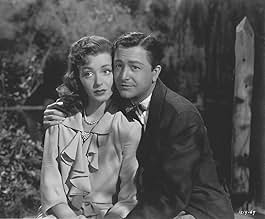Marsha Hunt(1917-2022)
- Actress
- Additional Crew
- Soundtrack
Stardom somehow eluded this vastly gifted actress. Had it not perhaps
been for her low-level profile compounded by her McCarthy-era
blacklisting in the early 1950s, there is no telling what higher tier
Marsha Hunt might have attained. Perhaps her work was not
flashy enough, or too subdued, or perhaps her intelligence too often
disguised a genuine sex appeal to stand out among the other lovelies.
Two studios, Paramount in the late 1930s and MGM in the early 1940s,
failed to complete her star. Nevertheless, her talent and versatility
cannot be denied. This glamorous, slimly handsome leading lady offered
herself to well over 50 pictures during the 1930s and 1940s alone.
Christened Marcia Virginia Hunt, the Chicago-born actress was the younger of two girls born to an attorney and voice teacher/accompanist. The family relocated to New York when she was quite young and she attended such schools as PS #9 and Horace Mann School for Girls. She developed an interest in acting at an early age (3), performing around and about in school plays and at church functions. Following her high school graduation the young beauty found work as a John Powers model and as a singer on radio, a gift obviously inherited from her mother. Marcia (she later changed the spelling of her first name to Marsha) studied drama at the Theodora Irvine Drama School (one of her fellow students was Cornel Wilde).
Encouraged to try Hollywood by various New York people in the business, the young photogenic hopeful moved there in 1934. She was only 17 but was accompanied by her older sister. It didn't take long for the studios to take an interest in her and she was signed up by Paramount not long after. Marsha's very first movie was in a featured role opposite Robert Cummings and Johnny Downs in the old-fashioned The Virginia Judge (1935). Displaying an innate, fresh-faced sensitivity, she moved directly into her second film, playing the title role in Gentle Julia (1936), this time with Tom Brown as her romantic interest.
Marsha continued to show promise but these well-acted roles were, more often than not, overlooked in mild "B"-level offerings. Appearing in co-starring roles in everything from westerns (Desert Gold (1936) and Thunder Trail (1937)) to folksy or flyweight comedy (Easy to Take (1936) and Murder Goes to College (1937)), she could not find decent enough scripts at Paramount. Though she was once deemed one of the studio's promising starlets, one of her last films there was another prairie flower role--[error]--with cowboys John Wayne and Johnny Mack Brown vying for her attention. At about this time (1938) she married Jerry Hopper, a Paramount film editor who turned to directing in the 1950s. This marriage lasted but a few years.
Freelancing for a time for many studios, Marsha's more noticeable war-era work in sentimental comedy and staunch war dramas came from MGM, and she finally signed with the studio in 1939. The roles offered, which included a featured part as one of the sisters in Pride and Prejudice (1940) starring Greer Garson, and again as a sister to Garson in Blossoms in the Dust (1941), which showed much more promise. Some of her better war-era roles came in the films Cheers for Miss Bishop (1941), Kid Glove Killer (1942) and The Affairs of Martha (1942). During this time she also sang on extended USO tours and stayed busy on radio. Her best known film is arguably The Human Comedy (1943) but she wasn't the star. Other film roles had her in support of others, such as Margaret Sullavan in Cry 'Havoc' (1943), little Margaret O'Brien in Lost Angel (1943) and Garson again in The Valley of Decision (1945). Leading roles did not come in "A" pictures.
Her MGM contract was allowed to lapse in 1945 and a second marriage in 1946, to screenwriter Robert Presnell Jr., became a higher priority. The marriage was long and happy (exactly 40 years) and lasted until his passing in June of 1986. The few pictures she made were, again, uneventful or in support of the star, although she did have a catchy, unsympathetic role in the Susan Hayward starrer Smash-Up: The Story of a Woman (1947) as a scheming secretary. In Raw Deal (1948), starring Dennis O'Keefe, she got the "raw deal" being overshadowed as a "good girl" by the "bad girl" posturings of Claire Trevor. At this point of her career she decided to try the stage and made her Broadway debut in "Joy to the World" (1948). Other plays down the road would include "The Devil's Disciple" with Maurice Evans, "The Lady's Not for Burning" with Vincent Price and "The Little Hut" with Leon Ames. She even had a chance to return to her beloved singing as Anna in a production of "The King and I" and (much later) in productions of "State Fair" and "Meet Me in St. Louis". TV also yielded some new work opportunities, including a presentation of "Twelfth Night" in which she portrayed Viola.
The seams of her film career fell apart in the early 1950s. During the late 1930s and into the 1940s she signed a number of petitions promoting liberal ideals, and was a member of the Committee for the First Amendment. A strong supporter of freedom of speech, these associations led to her name appearing in the pamphlet "Red Channels", a McCarthy-era publication that "exposed" alleged Communists and "subversives". Although she and her husband were never called before the House Un-American Activities Commission, their names were nevertheless smeared all over Hollywood as "Reds". While she still found film work on occasion, it was rare. Although she had worked steadily from 1935 until 1949, appearing in over 50 films, she made only three films in the next eight years. Her screenwriter husband would be credited for only one film from 1948 to 1955.
Semi-retired by the early 1960s, stage and TV became Marsha's focal points. She also devoted herself to civil rights causes and such humanitarian efforts as UNICEF, The March of Dimes and The Red Cross. She became actively involved with the United Nations. On the acting front she appeared only in smaller roles in five films but in numerous TV programs and made-for-TV movies, playing everything from judges to grandmas. She became the Honorary Mayor of Sherman Oaks, California, in 1983, and published a book on fashion entitled "The Way We Wore" in 1993. Widowed in 1986, the ever-vibrant Marsha, in her 90s, continues to serve on the Advisory Board of Directors for the San Fernando Valley Community Mental Health Center, a large non-profit that advocates for adults and children affected by homelessness and mental illness. As recently as 2006, she appeared to good advantage in the movie Chloe's Prayer (2006) and, at age 91, was seen in Empire State Building Murders (2008).
Christened Marcia Virginia Hunt, the Chicago-born actress was the younger of two girls born to an attorney and voice teacher/accompanist. The family relocated to New York when she was quite young and she attended such schools as PS #9 and Horace Mann School for Girls. She developed an interest in acting at an early age (3), performing around and about in school plays and at church functions. Following her high school graduation the young beauty found work as a John Powers model and as a singer on radio, a gift obviously inherited from her mother. Marcia (she later changed the spelling of her first name to Marsha) studied drama at the Theodora Irvine Drama School (one of her fellow students was Cornel Wilde).
Encouraged to try Hollywood by various New York people in the business, the young photogenic hopeful moved there in 1934. She was only 17 but was accompanied by her older sister. It didn't take long for the studios to take an interest in her and she was signed up by Paramount not long after. Marsha's very first movie was in a featured role opposite Robert Cummings and Johnny Downs in the old-fashioned The Virginia Judge (1935). Displaying an innate, fresh-faced sensitivity, she moved directly into her second film, playing the title role in Gentle Julia (1936), this time with Tom Brown as her romantic interest.
Marsha continued to show promise but these well-acted roles were, more often than not, overlooked in mild "B"-level offerings. Appearing in co-starring roles in everything from westerns (Desert Gold (1936) and Thunder Trail (1937)) to folksy or flyweight comedy (Easy to Take (1936) and Murder Goes to College (1937)), she could not find decent enough scripts at Paramount. Though she was once deemed one of the studio's promising starlets, one of her last films there was another prairie flower role--[error]--with cowboys John Wayne and Johnny Mack Brown vying for her attention. At about this time (1938) she married Jerry Hopper, a Paramount film editor who turned to directing in the 1950s. This marriage lasted but a few years.
Freelancing for a time for many studios, Marsha's more noticeable war-era work in sentimental comedy and staunch war dramas came from MGM, and she finally signed with the studio in 1939. The roles offered, which included a featured part as one of the sisters in Pride and Prejudice (1940) starring Greer Garson, and again as a sister to Garson in Blossoms in the Dust (1941), which showed much more promise. Some of her better war-era roles came in the films Cheers for Miss Bishop (1941), Kid Glove Killer (1942) and The Affairs of Martha (1942). During this time she also sang on extended USO tours and stayed busy on radio. Her best known film is arguably The Human Comedy (1943) but she wasn't the star. Other film roles had her in support of others, such as Margaret Sullavan in Cry 'Havoc' (1943), little Margaret O'Brien in Lost Angel (1943) and Garson again in The Valley of Decision (1945). Leading roles did not come in "A" pictures.
Her MGM contract was allowed to lapse in 1945 and a second marriage in 1946, to screenwriter Robert Presnell Jr., became a higher priority. The marriage was long and happy (exactly 40 years) and lasted until his passing in June of 1986. The few pictures she made were, again, uneventful or in support of the star, although she did have a catchy, unsympathetic role in the Susan Hayward starrer Smash-Up: The Story of a Woman (1947) as a scheming secretary. In Raw Deal (1948), starring Dennis O'Keefe, she got the "raw deal" being overshadowed as a "good girl" by the "bad girl" posturings of Claire Trevor. At this point of her career she decided to try the stage and made her Broadway debut in "Joy to the World" (1948). Other plays down the road would include "The Devil's Disciple" with Maurice Evans, "The Lady's Not for Burning" with Vincent Price and "The Little Hut" with Leon Ames. She even had a chance to return to her beloved singing as Anna in a production of "The King and I" and (much later) in productions of "State Fair" and "Meet Me in St. Louis". TV also yielded some new work opportunities, including a presentation of "Twelfth Night" in which she portrayed Viola.
The seams of her film career fell apart in the early 1950s. During the late 1930s and into the 1940s she signed a number of petitions promoting liberal ideals, and was a member of the Committee for the First Amendment. A strong supporter of freedom of speech, these associations led to her name appearing in the pamphlet "Red Channels", a McCarthy-era publication that "exposed" alleged Communists and "subversives". Although she and her husband were never called before the House Un-American Activities Commission, their names were nevertheless smeared all over Hollywood as "Reds". While she still found film work on occasion, it was rare. Although she had worked steadily from 1935 until 1949, appearing in over 50 films, she made only three films in the next eight years. Her screenwriter husband would be credited for only one film from 1948 to 1955.
Semi-retired by the early 1960s, stage and TV became Marsha's focal points. She also devoted herself to civil rights causes and such humanitarian efforts as UNICEF, The March of Dimes and The Red Cross. She became actively involved with the United Nations. On the acting front she appeared only in smaller roles in five films but in numerous TV programs and made-for-TV movies, playing everything from judges to grandmas. She became the Honorary Mayor of Sherman Oaks, California, in 1983, and published a book on fashion entitled "The Way We Wore" in 1993. Widowed in 1986, the ever-vibrant Marsha, in her 90s, continues to serve on the Advisory Board of Directors for the San Fernando Valley Community Mental Health Center, a large non-profit that advocates for adults and children affected by homelessness and mental illness. As recently as 2006, she appeared to good advantage in the movie Chloe's Prayer (2006) and, at age 91, was seen in Empire State Building Murders (2008).
Celebrities at Christmastime
Celebrities at Christmastime
See some of our favorite photos of celebrities getting into the spirit of the season.



